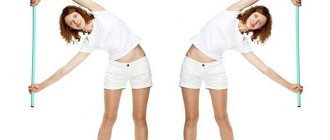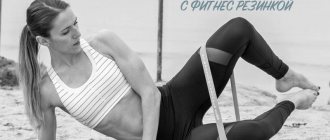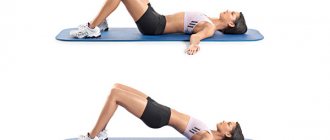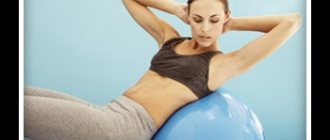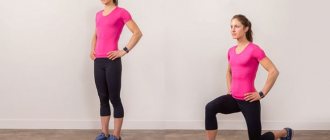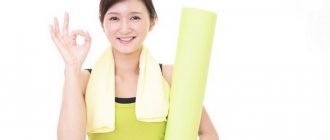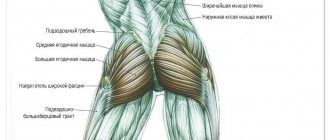A few weights on your legs and arms won't improve your appearance, but these simple accessories will instantly increase the intensity of your workout. Such weights are not suitable for all types of exercises, but they will definitely fit perfectly into light cardio . The effectiveness of the training will increase significantly, and its duration will be halved.
General information
Initially, leg weights were used exclusively in running disciplines. It's all about how they use the leg muscles. After all, if heavy squats with a barbell can significantly increase the volume of white muscle fibers, causing myofibrillar hypertrophy, then it was not possible to increase the size of the sarcoplasm and, accordingly, the endurance of the athlete’s legs.
Previously, training was used for this in the form of running on special surfaces, be it viscous soil or barefoot running without sneakers. In particular, such training has been popular with basketball players, who must not only maintain high endurance, but also have truly amazing explosive power for high jumps.
What is a leg weight? This is a design that includes:
- Filler. The weight of the weighting agent and its tightness to the foot depend on it.
- Cuff. The cuff attachment allows it to be attached to different parts of the leg.
- Attachment point. Depends on the type of weighting agent itself. There are weights that are attached exclusively below the calf muscle. And there is a type that involves wearing the entire structure on the quadriceps.
Interesting fact: in fact, the difference between weights for legs and arms is not that great. Many crossfit athletes use a universal design with convenient fastening and diameter adjustment. This allows you to attach the same weighting material to both arms and legs. But most importantly, it allows you to attach them to the wrist, quadriceps, calf or shoulder joint in order to increase leverage in specific exercises.

© wimage72 — stock.adobe.com
Types of weights
All weights are divided into two types:
- Bulk (with sand inside). They are cheaper in price, but less practical, since their weight cannot be adjusted.
- Metal (there are metal plates inside them). This type is more expensive, but it is very convenient to use, since its weight can be reduced or added.
Depending on what part of the body the weights need to be attached to, they come in the following varieties:
- Gloves - used in wrestling to enhance the blow. Their weight reaches 12 kg.
- The belt creates a load on the whole body. Can be used during fitness activities. Weight - up to 20 kg.
- Bracelets or cuffs – attached to the ankles or wrists to create extra weight.
- Vests - Originally used by the military to increase their stamina. Over time, they became popular among people who are seriously involved in sports. Weight - up to 48 kg.
This is interesting: Morning exercises No. 1
Criterias of choice
First of all, before choosing sports equipment, you need to decide why leg weights are needed in your particular case. If you're using them exclusively for HIIT, then you want the stiffest option with the most weight. If this is a cardio exercise, then you need to select weights based on the material and attachment point to avoid possible dislocations. And if you decide to choose leg weights for everyday wear, then you should think about their size and maximum inconspicuousness and wearing comfort.
| Selection criterion | How to evaluate? | Optimal solution |
| Weight of weight | Large weights are designed for basic exercises or walking. Medium weight weights are suitable for long runs. Light weight is suitable for practicing coordination of movements (for example, in striking types of exercises). | Depends on your goals. |
| Fabric cuff and fastenings | Two important factors depend on the fabric. The first is ease of wearing. The stiffer the fabric, the more likely it is that the weight will chafe. At the same time, the durability of the weighting agent itself depends on the rigidity of the fabric. | You need to choose based on your feeling of comfort. Fabric tears can always be sewn up. |
| Shape and attachment point | Leg weights come in oblong and classic cuff shapes. Long weights allow you to distribute the weight more evenly, but they very often compress the calf muscle, which creates some inconvenience when wearing. Cuffs are limited to small weights. At the same time, they have a more balanced load lever. | Depends on the condition of the veins and arteries. |
| Weight diameter | This determines whether you can wear weights under your clothes in everyday life. | Depends on your goals. |
| Filler used | There are three main types of weights:
| Depends on your goals. |
What to use it for?
Why do we need sports leg weights and how did this equipment come to CrossFit? Initially, athletes began to use it to prepare for workout-type complexes. For this purpose, designs with replaceable scales were used. Why was this necessary? It’s all very simple - when an athlete reaches a certain level of training, problems arise related to an imbalance in the proportions or fitness of certain muscle groups. Weights can help solve this problem. This is especially important for girls who, although involved in competitive CrossFit, still strive to remain as feminine and proportional as possible.
The second important feature is the ability to increase the intensity of heart contractions. As you know, competitive CrossFit is a big test for our heart muscle, and very often athletes, trying to get into peak shape, get athlete's heart syndrome. Leg weights allow you to more systematically increase the load on the heart muscle, even in the lightest WOD complexes. As a result, when an athlete is faced with truly strenuous exercise, his heart muscle is already prepared for such stress and, therefore, has better oxygen susceptibility.
In addition, weights indirectly affect the athlete's resistance to various environments, which can be useful in the case of training swimmers for whom balance between all muscle groups is important. So, Rich Froning did not hesitate to use weights before preparing for the Crossfit games 2014.
This equipment is often used for regular strength training in the gym or at home. In this case, they help increase the load on the leg muscles in exercises with your own weight or on certain machines, for example, when swinging legs in a crossover. Of course, using weights when training at home will not replace squats with a barbell or dumbbells, but it is better than nothing.
Complexes of exercises with weights
Using this sports equipment, you can pump up the muscles of the arms, legs, buttocks, abdomen, and chest. Below we will consider a system of exercises for them.
Exercises for legs, abdomen and buttocks
These are various leg lifts and swings. Weights are attached to the ankles, above sports shoes.
Removal of limbs to the side
Stand up straight, place your hands on your belt. Select your supporting leg and slowly move in the opposite direction, bending your other leg and trying to maintain your balance. Then change your supporting leg. Do abductions 10–15 times for each limb, gradually increasing the load.
Lifting the leg from a lying position
Lie on the floor on your right side. Place your curved right arm on the floor. Extend your other hand in front of you. Place the foot of your left curved leg on the floor. Make small swings with your right foot. For each leg, repeat the exercise 10–15 times.
Find out the most effective exercises for your legs and buttocks.
Kneeling Leg Raise
Get on your knees, place your hands on the floor. Extend your right leg. Her fingers should touch the floor. Do not bend your torso. From this position, lift your leg as far as possible 10–15 times. Repeat the same for your left leg.
Taking the leg back
Stand up straight, put your hands on your waist. Slowly move one leg back, then the other, without bending forward. Perform these actions 10–15 times for each limb.
Leg swings while lying down
Lying on your back, lift one leg 90°, then the other (10–15 times). Perform the same swings while lying on your side.
For chest and arms
This group consists of the following exercises.
Scissors for hands
Stand straight, extend your arms parallel to the floor, tense them. Do scissoring 20 times. After this, raise your arms above your head and repeat these steps the same number of times. “Scissors” are done in 2-3 approaches.
"Mill"
Stand straight with your feet shoulder-width apart. Lean forward 90°. Raise your right hand up and lower your left hand down. Rotate your hands, with your right hand touching the toe of your left foot, and your left hand touching the toe of your right foot. Do the exercise slowly at first, gradually, after which you can speed up.
"Hammer"
Take light dumbbells in your hands. Stand up straight. Place your arms close to your body. Raise the right dumbbell one by one to shoulder level, then the left. Do lifts 10–15 times on both limbs.
This is interesting: Nail extensions: gel or acrylic?
Jumping with arms raised
Stand up straight, lower your arms along your body. As you jump, spread your legs and simultaneously raise your arms above your head. Repeat steps 10–15 times.
You will also be interested in learning about the best exercises for men and women with a medicine ball, a barbell plate, and kettlebells.
Walking and running for weight loss
Athletes often practice race walking and running to lose weight. Let's look at how to perform race walking correctly:
- choose comfortable clothes and shoes;
- walk short but fast;
- don’t slouch, keep your stomach pulled in;
- bend your arms at the elbows, move them rhythmically, in accordance with the speed of your walking;
- breathing should be even;
- do not stop walking abruptly.
To begin with, it will be enough to conduct such training 4 times a week for 20 minutes, gradually increasing their duration.
Did you know? There are many types of race walking: Nordic walking (with poles similar to skiing), walking on stairs (the prototype of step aerobics), as well as mass walking, in which thousands of people cover long distances at the same time (it is especially popular in Japan).
As for running, you can do it in the morning (you will recharge your batteries for the whole day) or in the evening (as a good release after a hard day at work). Before your morning run, drink a glass of water and have breakfast 15-30 minutes after you finish.
To get the maximum effect from an evening run, it is recommended to have dinner 2 hours before it. You need to start running for short distances first, gradually increasing its duration. Be sure to choose the type of running that suits you (jogging, shuttle, sprint).
Harm and contraindications
Unfortunately, unlike arm weights, leg weights have certain disadvantages and contraindications:
- It is not recommended to wear weights for more than 6 hours at a time. They compress key arteries and veins, which increases swelling and can significantly limit leg mobility throughout the day.
- It is not recommended to use heavy lead cuffs. Despite their undeniable advantages in the form of successful fastening, fabric and invisibility, they cause lead poisoning.
- It is not recommended to practice striking movements while wearing heavy weights. Due to the change in the point of contact with the projectile, and most importantly due to the inertia of movement in the weights, the impulse movement will easily twist your knee joint.
- It is not recommended to wear weights for people suffering from varicose veins. The reason is the same as in the first case - pinching of arteries and veins.
Moving the leg to the side
Difficulty - medium. The inner and outer thighs and gluteal muscles work.
- Starting position: standing. Hands are either free or on the hip joints.
- Select the first supporting leg (let it be the left one). We lean on this limb, while exhaling we move our right leg to the side, and while inhaling we return it back.

We perform 10-15 such movements. We repeat similarly for the other leg.
This movement is shown even more clearly in the video:
